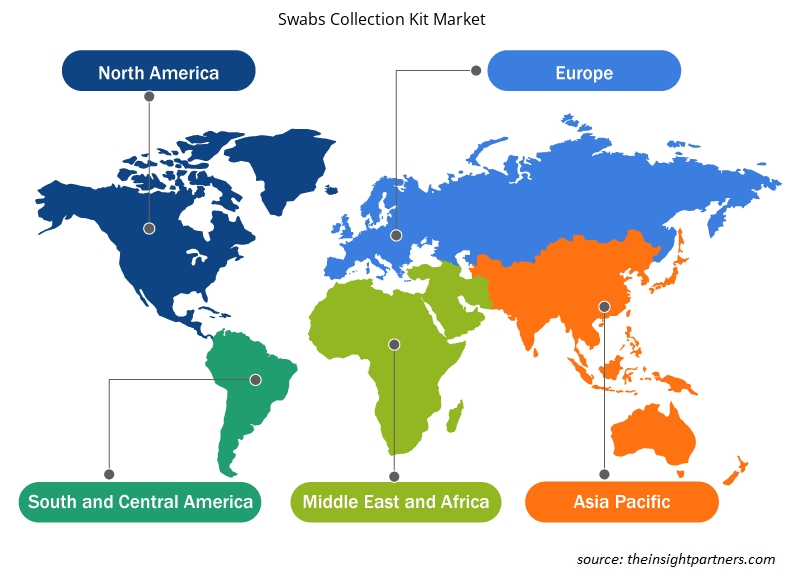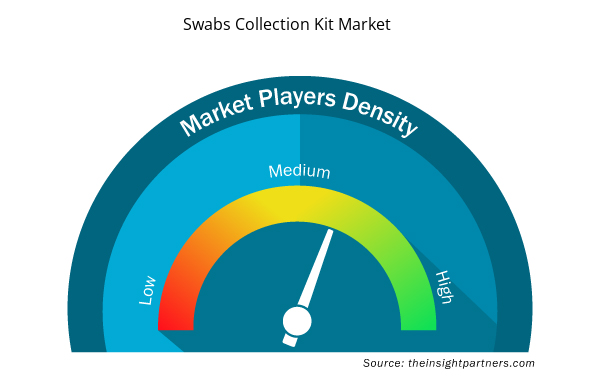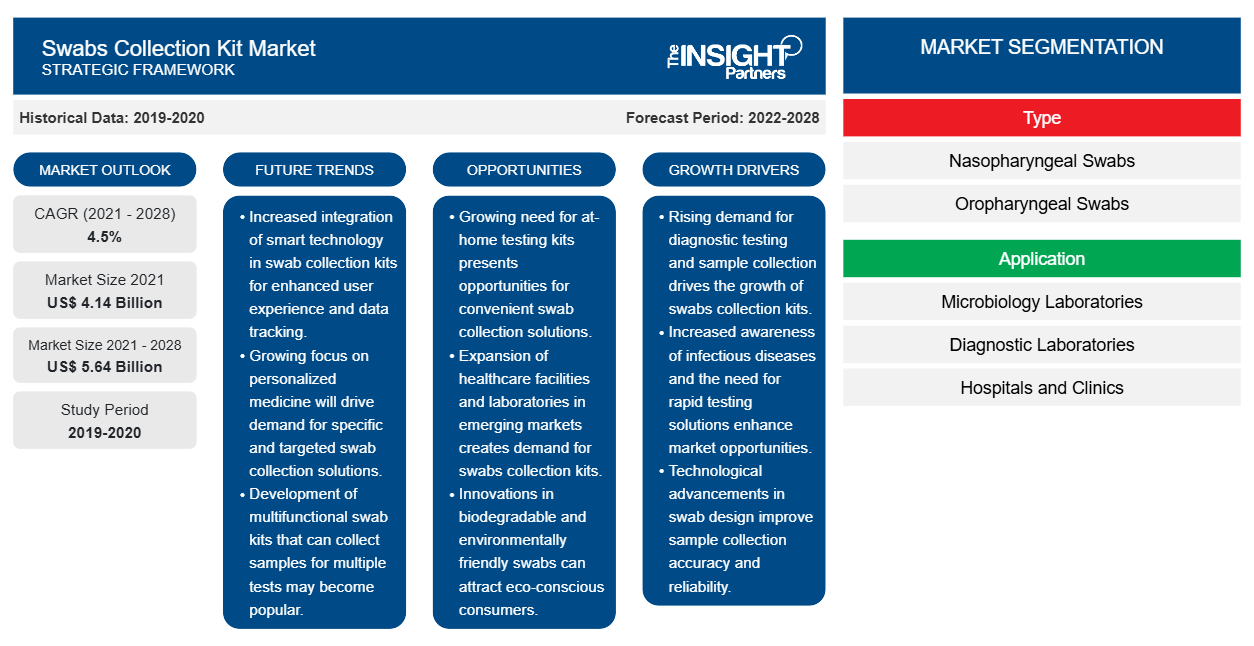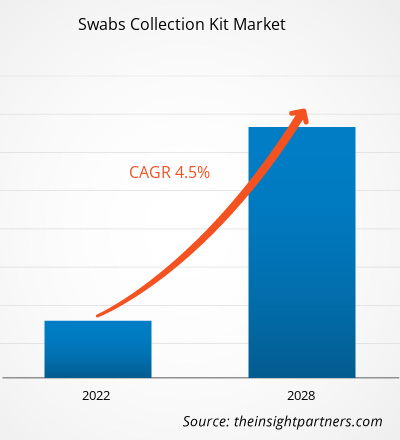Se espera que el mercado de kits de recolección de hisopos crezca de US$ 4141,32 millones en 2021 a US$ 5641,68 millones en 2028; se estima que registrará una CAGR del 4,5% entre 2021 y 2028.
Los kits de recolección de muestras con hisopos son hisopos estériles envueltos individualmente para usos de investigación biomédica o diagnóstico clínico. Aunque son especialmente populares en el campo, los hisopos se pueden utilizar en una variedad de entornos y aplicaciones de recolección de muestras, como en medicina, ciencia forense, genética, microbiología, preanálisis y diagnóstico.
El crecimiento del mercado de kits de recolección de hisopos se atribuye principalmente a factores como el aumento del número de casos de coronavirus y la creciente demanda de kits de recolección de hisopos precisos y modernos. Sin embargo, la falta de profesionales capacitados y la limitación de los métodos de recolección de hisopos, por ejemplo, la tasa de resultados falsos negativos en las pruebas de reacción en cadena de la polimerasa con transcriptasa inversa, son una gran preocupación que obstaculiza el crecimiento del mercado.
Personalice este informe según sus necesidades
Obtendrá personalización en cualquier informe, sin cargo, incluidas partes de este informe o análisis a nivel de país, paquete de datos de Excel, así como también grandes ofertas y descuentos para empresas emergentes y universidades.
- Obtenga las principales tendencias clave del mercado de este informe.Esta muestra GRATUITA incluirá análisis de datos, desde tendencias del mercado hasta estimaciones y pronósticos.
Perspectivas del mercado
Aumenta el apoyo gubernamental a las tecnologías médicas
En todo el mundo se están produciendo cada vez más inversiones en actividades de investigación y desarrollo médico. Por ejemplo, en febrero de 2017, la Asociación de la Industria de Dispositivos Médicos de la India (AiMeD) e Invest India firmaron un memorando de entendimiento para transformar a la India en un centro mundial de fabricación de kits de recolección de muestras.
Además, en agosto de 2019, la Administración Nacional de Tipos Médicos de China (NMPA) anunció la expansión del actual programa piloto de autorización de comercialización de dispositivos médicos de Shanghái, Pekín, Guangdong y Tianjin a 21 ciudades y provincias. El programa permite a las empresas de tecnología médica asignar actividades de I+D y fabricación en las ciudades y provincias piloto. Por ejemplo, un centro de I+D en Shanghái que tenga la aprobación regulatoria y la propiedad intelectual de un dispositivo puede subcontratar sus actividades de fabricación a áreas vecinas como Jiangsu y Zhejiang que tienen una mayor capacidad de fabricación. Por lo tanto, es probable que el creciente apoyo gubernamental a las tecnologías médicas favorezca el crecimiento del mercado.
Perspectivas basadas en tipos
El mercado de kits de recolección de hisopos, por tipo, se segmenta en hisopos nasofaríngeos, hisopos orofaríngeos y otros. Los hisopos nasofaríngeos tuvieron la mayor participación del mercado en 2021, mientras que se prevé que los hisopos orofaríngeos registren la CAGR más alta del mercado del 4,9 % durante el período de pronóstico.nasopharyngeal swabs, oropharyngeal swabs and others. The nasopharyngeal swabs held the largest share of the market in 2021, whereas the oropharyngeal swabs are anticipated to register the highest CAGR of 4.9% in the market during the forecast period.
Perspectivas basadas en aplicaciones
Por aplicación, el mercado de kits de recolección de hisopos se segmenta en laboratorios de microbiología, laboratorios de diagnóstico, hospitales y clínicas, pruebas caseras, entre otros. Es probable que los hospitales y las clínicas tengan la mayor participación del mercado en 2021, mientras que se prevé que los laboratorios de diagnóstico registren la CAGR más alta del mercado durante el período de pronóstico.
Los lanzamientos y las aprobaciones de productos son estrategias que las empresas suelen adoptar para ampliar su presencia global y sus carteras de productos. Además, los actores del mercado de kits de recolección de muestras se centran en la estrategia de asociación para ampliar su clientela, lo que, a su vez, les permite mantener su marca a nivel mundial.
Perspectivas regionales del mercado de kits de recolección de hisopos
Los analistas de Insight Partners explicaron en detalle las tendencias regionales y los factores que influyen en el mercado de kits de recolección de hisopos durante el período de pronóstico. Esta sección también analiza los segmentos y la geografía del mercado de kits de recolección de hisopos en América del Norte, Europa, Asia Pacífico, Medio Oriente y África, y América del Sur y Central.

- Obtenga datos regionales específicos para el mercado de kits de recolección de hisopos
Alcance del informe de mercado del kit de recolección de hisopos
| Atributo del informe | Detalles |
|---|---|
| Tamaño del mercado en 2021 | US$ 4,14 mil millones |
| Tamaño del mercado en 2028 | 5.640 millones de dólares estadounidenses |
| CAGR global (2021-2028) | 4,5% |
| Datos históricos | 2019-2020 |
| Período de pronóstico | 2022-2028 |
| Segmentos cubiertos | Por tipo
|
| Regiones y países cubiertos | América del norte
|
| Líderes del mercado y perfiles de empresas clave |
|
Densidad de actores del mercado de kits de recolección de hisopos: comprensión de su impacto en la dinámica empresarial
El mercado de kits de recolección de hisopos está creciendo rápidamente, impulsado por la creciente demanda de los usuarios finales debido a factores como la evolución de las preferencias de los consumidores, los avances tecnológicos y una mayor conciencia de los beneficios del producto. A medida que aumenta la demanda, las empresas amplían sus ofertas, innovan para satisfacer las necesidades de los consumidores y aprovechan las tendencias emergentes, lo que impulsa aún más el crecimiento del mercado.
La densidad de actores del mercado se refiere a la distribución de las empresas o firmas que operan dentro de un mercado o industria en particular. Indica cuántos competidores (actores del mercado) están presentes en un espacio de mercado determinado en relación con su tamaño o valor total de mercado.
Las principales empresas que operan en el mercado de kits de recolección de hisopos son:
- BD
- Productos médicos puritanos
- Corporación de laboratorio de América Holdings
- Laboratorios HiMedia
- Thermo Fisher Scientific Inc.,
Descargo de responsabilidad : Las empresas enumeradas anteriormente no están clasificadas en ningún orden particular.

- Obtenga el kit de recolección de hisopos Descripción general de los principales actores clave del mercado
El informe segmenta el mercado de kits de recolección de hisopos de la siguiente manera:
Mercado mundial de kits de recolección de hisopos: por tipo
- Hisopados nasofaríngeos
- Hisopados orofaríngeos
- Otros
Mercado mundial de kits de recolección de hisopos: por aplicación
- Hospitales y Clínicas
- Laboratorios de diagnóstico
- Laboratorios de microbiología
- Pruebas caseras
- Otros
Mercado mundial de kits de recolección de hisopos: por geografía
América del norte
- A NOSOTROS
- Canadá
- México
Europa
- Reino Unido
- Alemania
- Francia
- Italia
- España
- Resto de Europa
Asia Pacífico
- Porcelana
- Japón
- India
- Australia
- Corea del Sur
- Resto de Asia Pacífico
Oriente Medio y África
- Emiratos Árabes Unidos
- Arabia Saudita
- Sudáfrica
- Resto de Oriente Medio y África
América del Sur y Central
- Brasil
- Argentina
- Resto de América del Sur y Central
Perfiles de empresas
- BD
- Productos médicos puritanos
- Corporación de laboratorio de América Holdings
- Laboratorios HiMedia
- Fisher Scientific, Inc
- Diagnóstico Hardy
- VIRCELL SL
- BTNX, Inc
- Laboratorios Formlabs
- Diagnóstico Lucence
- Análisis histórico (2 años), año base, pronóstico (7 años) con CAGR
- Análisis PEST y FODA
- Tamaño del mercado Valor/volumen: global, regional, nacional
- Industria y panorama competitivo
- Conjunto de datos de Excel


- Health Economics and Outcome Research (HEOR) Services Market
- Neurovascular Devices Market
- Energy Recovery Ventilator Market
- Medical Second Opinion Market
- Fish Protein Hydrolysate Market
- Equipment Rental Software Market
- Photo Printing Market
- Medical Collagen Market
- Cell Line Development Market
- Small Satellite Market

Report Coverage
Revenue forecast, Company Analysis, Industry landscape, Growth factors, and Trends

Segment Covered
This text is related
to segments covered.

Regional Scope
North America, Europe, Asia Pacific, Middle East & Africa, South & Central America

Country Scope
This text is related
to country scope.
Preguntas frecuentes
The swabs collection kit market is led by type nasopharyngeal (NP) swabs are the highest-yield specimen type for upper respiratory viral diagnostic testing, including SARS-CoV-2, and the use of a flocked NP swab is the gold standard, according to the US FDA. At present, the demand for nasopharyngeal swab has prominently increased due to its incumbent use in diagnosis of active severe acute respiratory syndrome coronavirus 2 (SARS-CoV-2) infection. Rhinomed is a medical technology company based in Australia used its deep expertise in nasal airway technology to help overcome the global swab supply crisis in response to the COVID-19 pandemic. Other applications where nasopharyngeal swabs are used are for detection of a variety of upper and lower respiratory tract infections. With this constant innovation nasophayngeal swabs segment is likely to grow with a good pace in the forecasted period.
At-home testing kits are the testing instruments that help a person to perform tests at home and provide results in minutes. They also include health monitoring equipment to continuously check and control the health of the patient with antibody detection. At-home tests are very convenient to perform with comfort at home and are available at a very affordable rate. Self-tests are usually the advanced versions of rapid, point-of-care test kits that were originally designed for healthcare professionals and can be performed by the common person. The rising adoption of self-test and do-it-yourself (DIY) swab test kits due to convenience and rapid results is a major factor that is driving the collection kit market.
The growth of the region is attributed to factors such as rising public–private partnerships, and increasing funding activities are widely enhancing the performance of medical devices. Moreover, presence of well-developed healthcare infrastructure and government support are some of the prominent factors propelling the market growth in Asia Pacific. In Asia Pacific, India is the largest market for Microbial Air Sampler. The market growth in Asia Pacific is mainly attributed to factors such as the growing usage of microbial air samplers in combating Covid-19, increasing cases of food contamination by microbes. However concerns high capital investment for setting up advanced labs hinders the market growth in Asia Pacific.
The growth of the swabs collection kit market is mainly attributed to factors such as the rising number of COVID-19 cases and increasing demand for accurate and modern swabs collection kits. However, the lack of skilled professionals and limitation of swabs collection methods for instance, the rate of false-negative results in reverse transcriptase-polymerase chain reaction testing is a great concern to hinder the market growth. In July 2021, LabCorp has announced that Pixel by LabCorp COVID-19 PCR Test Home Collection Kits are now in 6,000 Walgreens stores nationwide and through Walgreens collaborations with on-demand delivery services DoorDash and Instacart. The newly expanded availability and delivery option advance Walgreens and LabCorp’s efforts to increase COVID-19 testing access in communities across the U.S., especially in underserved areas, which is contributing to the growth of the target market. Such strategic steps are also projected to drive the market growth.
Swab collection kits are individually wrapped sterile swabs for biomedical research or clinical diagnostic uses. Although especially popular in the field, swabs can be used in a variety of environments and specimen collection applications such as medical, forensics, genetics, microbiology, preanalytical, diagnostics. Sterile and individually wrapped fiber swabs are available in quantities of 50 with 20mm and 80mm break points. The swab collection kits provide a general-purpose collection method for molecular-based applications. Many sample types can be collected with these swab collection kits including from the mouth, nose, throat, and wherever a swab may be deemed appropriate per application. To use these swab collection kits, just swab any sample and break the tip into the swab collection kits tube prefilled with reagent. Samples are immediately stabilized and ready for transport or storage.
Trends and growth analysis reports related to Life Sciences : READ MORE..
The List of Companies - Swabs Collection Kit Market
- BD
- Puritan Medical Products
- Laboratory Corporation of America Holdings
- HiMedia Laboratories
- Thermo Fisher Scientific Inc.,
- Hardy Diagnostics
- VIRCELL S.L
- BTNX, Inc.
- Formlabs
- Lucence Diagnostics
The Insight Partners performs research in 4 major stages: Data Collection & Secondary Research, Primary Research, Data Analysis and Data Triangulation & Final Review.
- Data Collection and Secondary Research:
As a market research and consulting firm operating from a decade, we have published and advised several client across the globe. First step for any study will start with an assessment of currently available data and insights from existing reports. Further, historical and current market information is collected from Investor Presentations, Annual Reports, SEC Filings, etc., and other information related to company’s performance and market positioning are gathered from Paid Databases (Factiva, Hoovers, and Reuters) and various other publications available in public domain.
Several associations trade associates, technical forums, institutes, societies and organization are accessed to gain technical as well as market related insights through their publications such as research papers, blogs and press releases related to the studies are referred to get cues about the market. Further, white papers, journals, magazines, and other news articles published in last 3 years are scrutinized and analyzed to understand the current market trends.
- Primary Research:
The primarily interview analysis comprise of data obtained from industry participants interview and answers to survey questions gathered by in-house primary team.
For primary research, interviews are conducted with industry experts/CEOs/Marketing Managers/VPs/Subject Matter Experts from both demand and supply side to get a 360-degree view of the market. The primary team conducts several interviews based on the complexity of the markets to understand the various market trends and dynamics which makes research more credible and precise.
A typical research interview fulfils the following functions:
- Provides first-hand information on the market size, market trends, growth trends, competitive landscape, and outlook
- Validates and strengthens in-house secondary research findings
- Develops the analysis team’s expertise and market understanding
Primary research involves email interactions and telephone interviews for each market, category, segment, and sub-segment across geographies. The participants who typically take part in such a process include, but are not limited to:
- Industry participants: VPs, business development managers, market intelligence managers and national sales managers
- Outside experts: Valuation experts, research analysts and key opinion leaders specializing in the electronics and semiconductor industry.
Below is the breakup of our primary respondents by company, designation, and region:

Once we receive the confirmation from primary research sources or primary respondents, we finalize the base year market estimation and forecast the data as per the macroeconomic and microeconomic factors assessed during data collection.
- Data Analysis:
Once data is validated through both secondary as well as primary respondents, we finalize the market estimations by hypothesis formulation and factor analysis at regional and country level.
- Macro-Economic Factor Analysis:
We analyse macroeconomic indicators such the gross domestic product (GDP), increase in the demand for goods and services across industries, technological advancement, regional economic growth, governmental policies, the influence of COVID-19, PEST analysis, and other aspects. This analysis aids in setting benchmarks for various nations/regions and approximating market splits. Additionally, the general trend of the aforementioned components aid in determining the market's development possibilities.
- Country Level Data:
Various factors that are especially aligned to the country are taken into account to determine the market size for a certain area and country, including the presence of vendors, such as headquarters and offices, the country's GDP, demand patterns, and industry growth. To comprehend the market dynamics for the nation, a number of growth variables, inhibitors, application areas, and current market trends are researched. The aforementioned elements aid in determining the country's overall market's growth potential.
- Company Profile:
The “Table of Contents” is formulated by listing and analyzing more than 25 - 30 companies operating in the market ecosystem across geographies. However, we profile only 10 companies as a standard practice in our syndicate reports. These 10 companies comprise leading, emerging, and regional players. Nonetheless, our analysis is not restricted to the 10 listed companies, we also analyze other companies present in the market to develop a holistic view and understand the prevailing trends. The “Company Profiles” section in the report covers key facts, business description, products & services, financial information, SWOT analysis, and key developments. The financial information presented is extracted from the annual reports and official documents of the publicly listed companies. Upon collecting the information for the sections of respective companies, we verify them via various primary sources and then compile the data in respective company profiles. The company level information helps us in deriving the base number as well as in forecasting the market size.
- Developing Base Number:
Aggregation of sales statistics (2020-2022) and macro-economic factor, and other secondary and primary research insights are utilized to arrive at base number and related market shares for 2022. The data gaps are identified in this step and relevant market data is analyzed, collected from paid primary interviews or databases. On finalizing the base year market size, forecasts are developed on the basis of macro-economic, industry and market growth factors and company level analysis.
- Data Triangulation and Final Review:
The market findings and base year market size calculations are validated from supply as well as demand side. Demand side validations are based on macro-economic factor analysis and benchmarks for respective regions and countries. In case of supply side validations, revenues of major companies are estimated (in case not available) based on industry benchmark, approximate number of employees, product portfolio, and primary interviews revenues are gathered. Further revenue from target product/service segment is assessed to avoid overshooting of market statistics. In case of heavy deviations between supply and demand side values, all thes steps are repeated to achieve synchronization.
We follow an iterative model, wherein we share our research findings with Subject Matter Experts (SME’s) and Key Opinion Leaders (KOLs) until consensus view of the market is not formulated – this model negates any drastic deviation in the opinions of experts. Only validated and universally acceptable research findings are quoted in our reports.
We have important check points that we use to validate our research findings – which we call – data triangulation, where we validate the information, we generate from secondary sources with primary interviews and then we re-validate with our internal data bases and Subject matter experts. This comprehensive model enables us to deliver high quality, reliable data in shortest possible time.


 Obtenga una muestra gratuita de este informe
Obtenga una muestra gratuita de este informe